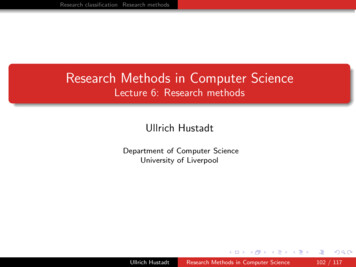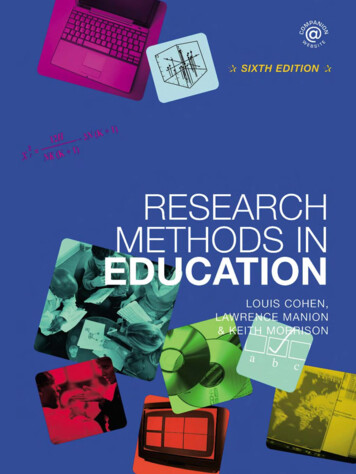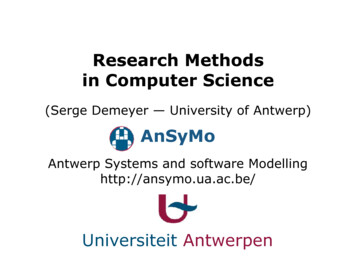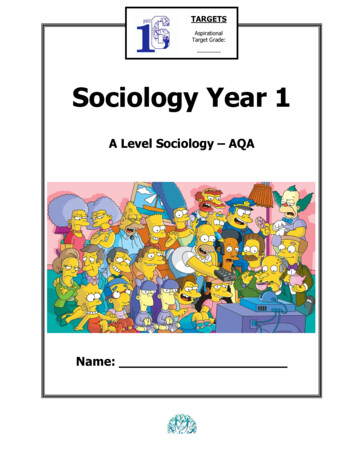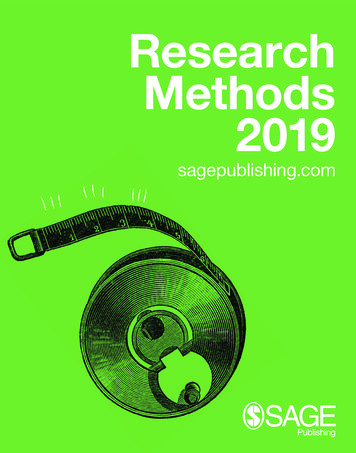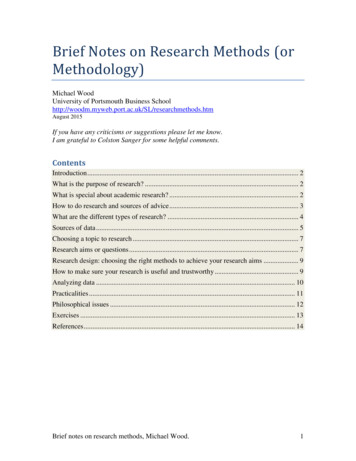
Transcription
Brief Notes on Research Methods (orMethodology)Michael WoodUniversity of Portsmouth Business hods.htmAugust 2015If you have any criticisms or suggestions please let me know.I am grateful to Colston Sanger for some helpful comments.ContentsIntroduction . 2What is the purpose of research? . 2What is special about academic research? . 2How to do research and sources of advice . 3What are the different types of research? . 4Sources of data . 5Choosing a topic to research . 7Research aims or questions . 7Research design: choosing the right methods to achieve your research aims . 9How to make sure your research is useful and trustworthy . 9Analyzing data . 10Practicalities . 11Philosophical issues . 12Exercises . 13References . 14Brief notes on research methods, Michael Wood.1
IntroductionMy aim here is to give a very brief overview of some of the main methodological pointsyou should be aware of when planning your own research, or deciding whether youshould trust research that someone else has done. I've just read that the advice not to eattoo much salt because of the danger of raised blood pressure was misguided; salt was, thearticle says, wrongly blamed. Should I believe the new advice or the old advice? To cometo a sensible decision you look, critically, at the research studies on which the contrastingrecommendations are based - which of them are more likely to be right?My focus is on management research, but many similar issues apply to other areas likeeducation, medicine, or sciences like genetics.What is the purpose of research?The idea of research is of course, is to make discoveries, understand things better, and inlong run to improve things.It’s useful to make this a little more definite by thinking of what the outputs from aresearch project might be. I can think of four possibilities:1Discovering the truth about something2Creating, modifying or justifying a theory or model of something3Finding a good, or better, way of doing or implementing something4Creating something like a computer program for stock control, or a trainingcourse.This is a rather muddled list, it's probably not complete, and the categories may overlap.The outputs may be in the form of a report for the audience to read (about the truth forexample), or a computer program, or some teaching materials, or a combination ofseveral of these.What is definitely worth noting is that there are two, apparently very different, criteria forevaluating these outputs. The first is "Is it true?" And the second is "Is it useful?" Therelationship between these two is subtle and need not concern us unduly here, except toremember that, ultimately, the aim of a research project is usually to improve the futureby finding out how to manage better. This might be directly by 3 or 4 above. Or it mightbe indirectly by a better understanding of the present situation (1), or better theories abouthow things work (2). So in this sense at least, usefulness is the primary aim.The usefulness criterion begs the question: useful for what? What is it that we value happiness, money, or whatever? And whose happiness, or whose money matters? Thesevalue judgments needs very careful consideration.What is special about academic research?The word academic comes from Plato’s Academy in ancient Greece which is seen as aforerunner of modern universities. “Academic” research means research that is goodenough for a university. Such research must beBrief notes on research methods, Michael Wood.2
Systematic and as thorough and trustworthy as possibleClearly written and with sufficient detail for readers to check things like thesources of informationEthicalWe’ll look at how to achieve this in practice below. The main thing is to write for a“critical” reader: someone who is sceptical about your work and needs to be convincedthat your conclusions are justified. Imagine the objections this person might have, and tryto answer them.Above all, remember that the results of research should be trustworthy, right or useful(which word makes most sense depends on the research). Suppose that you see a researchreport that claims that a new computer based course is highly effective for training salesstaff. Before believing the research, and investing in the new course, you would want tocheck if the research is done in a sensible way. If you found that most of the evidencecame from interviews with the developers of the course, you would suspect that theresults might be biased! Similarly, if the people used to test the course were all computergames addicts, you might wonder whether the results would be the same with otherpeople.How to do research and sources of adviceThe obvious approach is:1 Decide what you want to achieve - the aims of the project, or the questions it willanswer.2 Decide how you are going to achieve these aims or answer these questions - thedesign of your research project and the methods you will use.3 Do the research and analyse the results4 State the conclusions and recommendations.5 Check that you have in fact achieved the aims of the project. If you have not, workout your excuses, try again, or pretend that you were really trying to do somethingelse – i.e. change your aims to fit what you actually did (this is often acceptable).One difficulty with this is that you may not know exactly what you want to achieve at theoutset. Or you may change your mind about your research aims, or the best methods, as youdo the research. In general, it is best to plan your research in advance as far as possible, butbe flexible and expect to change your mind to some extent.You will find many books on research methods in the library. Saunders et al (2007 or lateredition) is a popular, student-friendly book; Robson (2002) is better on the more advancedconcepts; and there are many others. You won’t need to read them from cover to cover; justread the sections which are relevant to your project.In addition to books on research methods, you will also need to read articles about yourresearch topic. Many of these articles will discuss the methods used by the authors in doingtheir research.Brief notes on research methods, Michael Wood.3
And besides these, don’t forget your common sense. How to do research is mostly fairlyobvious – don’t allow the jargon in the books to make you forget this! Your starting pointshould always be common sense (link to come).What are the different types of research?There are many approaches to research, and many different types of analysis that count asresearch. Some of the commoner ones are listed below, but no list like this can becomplete. Obviously, the summaries below are very brief: you should read up about theapproaches that seem most suitable for your research. Large scale surveys (of people, organisations, events, etc) analysedstatistically (see most research methods books). The advantage of a bigsample is that you get more of the overall picture, but this picture may be a bitsuperficial. Small scale surveys with emphasis on “qualitative” or “rich” detail (see mostresearch methods books). The problem here is that the smallness of the samplemay mean that it is difficult to know how typical your results are, and how faryour results can generalised. On the other hand you will learn in more depthabout your small sample. The choice may be between learning a little about alot, or a lot about a little. Both have obvious advantages and disadvantages. Case studies – to see how something works in detail (see most researchmethods books). This is a respectable type of research, and often very helpfulto explore in detail how something can work in practice. It is important to useseveral sources of data for an in-depth analysis of the case. Experiments (see most research methods books; Ayres, 2007; Wood, 2003,Chapter 10 - http://woodm.myweb.port.ac.uk/nms.pdf; or search the web for"design of experiments"). The simplest type of experiment involvescomparing two groups which differ in just one way. For example, one groupof people used one version of a website, and a second group used a secondversion. If the second version of the website is more effective than the first(perhaps the second group buy more), then if the groups are big enough andwe are sure there are no other systematic differences between them, we canconclude that the difference in the websites causes the difference ineffectiveness. It is important that people are randomly assigned to the twogroups to ensure that there are no such systematic differences. Widely used inmedicine where they are called randomized controlled trials. Often difficult toarrange in management, although they are suggested by the BritishGovernment for testing to see if policies are likely to work – iles/resources/behaviourchange-and-energy-use.pdf ). Hadfield 81.400-drink-to-think.html)and Heras et al (2002: http://tinyurl.com/ydxn8jh) describe research whereexperiments might help – in principle, but in practice there may be difficulties. Quasi-experiments (see Robson, 202: 133-154; Grant & Wall, 2008). Theseare experiments which are not proper experiments because some of thevariables are not controlled – often randomization of groups is not possible.Brief notes on research methods, Michael Wood.4
One common possibility is a comparison of something before and after asupposed improvement – this is described as a design to avoid by Robson(2002: 139) but it may still be worth doing if you remember that there may bea number of different reasons for any improvement you find.Models can be set up, and tested (see the literature on the particular type ofmodel). For example you might set up a model for stock control, ormonitoring quality, or buying portfolios of shares, and then test whether yourmodel is useful.Action research – combining the roles of researcher and actor (see mostresearch methods books). There are obvious advantages, but also equallyobvious problems (mainly the possibility of bias), with this approach toresearch. and may other possibilities be imaginative! Browse the research methodsbooks, or devise your own methods to fit your particular research.Many projects combine several of these approaches, as this is usually the best way to getuseful results about a real situation.Sources of dataThe word “data” refers to information about the real world. All of the types of researchlisted above need data. It is important to be open minded about possible sources of data.The obvious possibilities include: Interviews – including various approaches to eliciting comments – e.g. “photoelicitation”. Questionnaires, including via email. It is more difficult to design a goodquestionnaire survey than it may seem. Read a book for advice, and do a pilot andlearn from it (and see below). Various structured techniques for getting information and views from groups ofpeople – e.g. focus groups, Delphi technique (Robson, 2002:57), brainstorming,etc. Observations of various kinds, including participant observation – which hasobvious advantages but also problems. Documents and archives (minutes of meetings, company reports, etc) The web Databases – within organisation, of share prices, etc Published data and statistics (e.g. at http://www.statistics.gov.uk/ andhttp://www.data-archive.ac.uk/ .) Etc . Be imaginative!Sometimes a distinction is made between primary data – which you have collectedyourself for your research – and secondary data – which has been collected by someoneelse. Secondary data may be available in published case studies or statistics. If you canobtain suitable secondary data, it would obviously be stupid not to use it. However, oftenBrief notes on research methods, Michael Wood.5
you will need to collect data about the specific situation of concern to your research, andso you will need your own (primary) data.You will find more detail of these in any book on research methods. With many of theseapproaches you will need to consider (and discuss in you written report) the practicalorganization of how the interview (for example) was run, the possibility that thequestions asked might bias the answers, and so on. It is also good practice to give readersaccess to at least a bit of the “raw” data (copies of questionnaires, transcripts of someinterviews, etc) so that they can see in detail what you did. This might be in the appendixor on a website – you should mention this in the text so readers know where to look.Questionnaires may seem easy to produce, but they are very difficult to design well.Points to remember include: If possible use, or adapt, someone else’s questionnaire, particularly if they havetested it thoroughly. You may need to get permission, but this has several obviousadvantages. Do a pilot of the whole process including the analysis – i.e. try it out with a smallgroup (possibly friends if they have the right background). Include yourself in thepilot! This should enable you to find and correct many problems. Consider an online or email survey – Google Forms (click on Documents in yourGmail home page, then Create new – Form) is worth considering. (The freeversion of Survey Monkey is useless: you will need to pay if you use this.) Keep it as simple and short as possible. This is difficult but very, very important.The questions should be phrased in the simplest way you can to avoidmisunderstandings. Avoid leading questions like “Explain why you like the newstrategy” or "When did you last beat your husband?" – perhaps some respondentsdon’t like the strategy or don't have battered husbands. And check each questionto see if you need the answer: if you don’t, delete the question. You need a short, clear, polite, grateful covering letter, perhaps offering asummary of the results. Remember the problems of sampling (is your sample likely to be biased?),persuading people to fill it in, distributing it, getting the results back, etc. Consider interviewing people instead. Use closed questions (tick the box, or circle a number on a scale) when possiblebecause they are easier to analyse, but it is usually a good idea to include a fewopen questions which people answer in their own words: e.g. "Is there anythingelse you can tell me that may be of interest?" Think about whether you want to ask what respondents did yesterday, what theyusually do, what they think, what they think other people think, what they thinkthe answer to your research question is and remember that they may not haveanything sensible to say. Questionnaires are hard work to organise, people hate filling them in, and theresults are often superficial and disappointing. According to Salancik (1979) theyare mere “autoerotic fantasies”. Are you sure you really want to do one? Theremay be other possibilities.Brief notes on research methods, Michael Wood.6
Choosing a topic to researchThe main things to consider are: Usefulness and interest. Will the results be useful? Will they make the world abetter place? Or will readers just be left asking “So what?” or “I know thisalready.” Will acquiring a state-of-the-art expertise in the topic help your career? Feasibility. Are you likely to be able to get the data, etc to research the topicproperly? The project should be reasonably challenging, but not impossible.Research aims or questionsWhat do you want to achieve by doing your research? Perhaps you want to devise a goodway of managing innovation in a particular context, or to see how a product can be marketedmore effectively, or to investigate stress in a particular type of work with a view toalleviating some of the problems. The starting point of your project should always be theoutcome that you want to achieve – this should then be the basis of your research aims orquestions.Sometimes the research aims or questions are quite clear. More typically, a research projectmay start from a fairly fuzzy problem or area of concern; it is then necessary to decide on aclear focus by formulating some more definite aims or questions. It is almost always betterto focus on a limited area so that you can do a thorough job, rather than having a broadfocus with inevitably superficial results. Unless, of course, you think you can crack the bigquestions, in which case, good luck!You also need to answer the question of why your aims are important. They may be ofimportance to your organization, they may be important to you, or they may be an importantcontribution to the literature – you may want to test or extend or create a theory or model.The important thing is to make sure that the practical outcomes of your research are likely tobe useful to someone. Your personal aims for doing the project - perhaps to pass the courseand acquire a marketable skill - are, of course, distinct from the research aims of the project.The focus for your research project, its goals, can then be formulated in any of the followingways: Question(s) to be answered: eg What is the best quality strategy for ABCCompany? Aim(s) (or objectives) to the achieved: eg To devise the best quality strategy forABC Company. A hypothesis or hypotheses to be tested: eg Strategy X is the best strategy forABC Company. (A hypothesis is a statement whose truth you want to test.)Aims and questions are more or less equivalent. Whether you express your goals as a list ofaims or as a series of questions does not matter much. There is no point in doing both, ofcourse.Brief notes on research methods, Michael Wood.7
However, in general, I would advise you against formulating the aims of your project as aseries of hypotheses to be tested. Testing hypotheses in management is more difficult than itmay appear, and the results of the research become a simple list of True/False statements –which may not be terribly useful. But, of course, there are exceptions.Despite this, it may be useful to have an informal hypothesis - eg TQM is helpful - to guideyour research. Then you can formulate some more detailed aims spelling out which aspectsof the helpfulness of TQM that you wish to investigate. You may also have hypotheses youwish to test as a part of addressing your research aims. For example, you may wish to testthe hypothesis that there is no difference in effectiveness between two procedures.It is a good idea to summarize the main aim of your research in a single phrase or sentence –for example: To devise and justify a better marketing strategy for Company X.This may then be broken down into subsidiary aims that will help you to achieve your mainaim – To measure the effectiveness of the existing strategy To investigate the approaches used by other organisations and their effectiveness To devise some suggestions for improvement To see how effective these improvements are.You may also want to use your results to improve the relevant academic theory, so that yourresults can be applied to other organisations: To modify an existing / create a new model for designing marketing strategies ina given sectorThis is roughly the pattern of many student projects in management (if you swap marketingfor HRM, quality or whatever).The research aims or questions should be as simple and clear as possible; be coherent (fit together), refer to practical and/or theoretical outcomes; be listed near the start of the project report.You will also need to make the scope of the research clear (will it refer to one company orbe broader, for example?) and clarify the meaning of any key terms used.Try to envisage the sort of conclusions which you might expect to arrive at. Then askyourself: Are you likely to be able to get the evidence to justify these conclusions? Are the conclusions worth the effort. Put yourself in the position of a critic whosays, simply, "So what?".At the end of the project report, you should have a clear section explaining how you haveachieved the aims (or answered the questions) laid out near the beginning. (If you find thatyou have not achieved the aims you originally set yourself, but have achieved somethingelse, then rewrite your aims so that the project makes sense to the reader!)Brief notes on research methods, Michael Wood.8
Research design: choosing the right methods to achieveyour research aimsGo through each of your aims and decide on the best methods to achieve them. Forexample, if the aim is to find a good strategy to "improve" X in Organization Y, then apossible design may be:1. Survey/case studies of Organization Y to investigate problems andopportunities2. Survey/case studies to see how other organisations do X and whichapproaches work well3. Based on (1), (2), the literature, and perhaps creative inspiration,consultations within the organisation, simulation or modelling, devisea strategy likely to improve X4. Try/test/pilot/monitor the proposed strategy, probably in a limiteddomainThis is fairly general pattern for many management projects, although for practicalreasons (like the time available) you may not manage to do all four parts.One of the problems with a lot of management research is that it concerns the future –typically the goal is to improve life in the future. The future, of course, has not happenedyet, and so is difficult to research; I have explored some possible methods for researchingthe future in http://woodm.myweb.port.ac.uk/NotHappened.ppt .If you have several aims you should write down the methods to achieve each of them.This will probably involve several different methods.Designing research is not easy. Think hard about what will work best. Then check to seeif you can spot any difficulties. Then work through the checks in the next section and thelinked document. Then think again!How to make sure your research is useful andtrustworthySome research is not really useful, either because no practical recommendations followfrom it, or because it’s obvious stuff that everyone knows without formal research. Andsome research is not done with sufficient care to make it trustworthy. What are the thingsyou should check?I have put my answers to this question in another document athttp://woodm.myweb.port.ac.uk/rm/u3critic.pdf . I think the most important things tocheck are: Have you got (or are you likely to get when you’ve done the planned research)trustworthy answers to questions about the Causes of success and failure? Ifyou want to make recommendations you need to get this right. Otherwise yourBrief notes on research methods, Michael Wood.9
recommendations aren’t likely to work. It is easy to jump to the wrongconclusions: imagine an alien landing on earth, noticing that people withbroken legs tend to have them encased in a plaster cast, and concluding that itis these plaster casts that break people's legs! Take care. Often a controlledexperiment (see above) is the only foolproof way of establishing what causeswhat.Are the samples of data you are using chosen in such a way that they arelikely to be Representative of the pattern in the wider world? If your sample isbiased, or too restricted, your results may be useless. It is always a good ideato think long and hard about your sample, particularly if your sample is small.This is particularly important for samples of one – typically known as casestudies.Are the measures or performance Indicators used to assess things sensible? Ifyour research concerns quality and profitability, have you got valid ways ofmeasuring these? If, for example, you assess company performance by askingfor the opinions of managers in the company, your results are likely to bebiased and useless.These are discussed in more detail, and there are some more things to check, athttp://woodm.myweb.port.ac.uk/rm/u3critic.pdf . (The italicised words above are the firstthree words of the acronym CRITICAL in this document.) These are very important ifyou want people to believe in the value of your research. They should be discussedsomewhere in your project. They are also a useful checklist for assessing the credibilityof other people’s research.Analyzing dataIt is difficult to generalize about analyzing your data and deriving conclusions from itbecause the best way to do it depends on your particular research. However there are twocommon types of analysis.First, there is statistical analysis. This ranges from tables of averages and bar charts tocomplex methods such as factor analysis and multiple regression. There are somesuggestions at http://woodm.myweb.port.ac.uk/stats/StatNotes0.pdf .Second, you may have “qualitative” data (words or speech) from interviews or fromopen-ended questions in questionnaires. You will find various suggestions in thetextbooks. On a simple level, I would suggest: If you have a lot (say 20 ) of cases, it may be worth coding your data, andthen analysing it statistically. For example, suppose you have asked collegestudents who have left their course about the reasons for leaving. You couldthen categorise them into categories like “didn’t like course”, “found a job”,etc, and analyze the frequency of each category. If you do this you shouldcheck the reliability of your categorization by getting another judge to checkhow you have categorized a sample of your sample.Brief notes on research methods, Michael Wood.10
If you have two more cases, it may be worth making a data table with eachcase on a separate row, and each question or other bit of information in aseparate column. Then in each cell you can make a note about how Case Xanswered Question Y. This should help you to spot and analyze any patterns.You can also treat each interview, or other bit of data of whatever kind, as acase to help you explore particular possibilities. Suppose you are researchingthe impact of mobile technology on work-life balance, and find that one ofyour interviewees has reduced their time in the office by 80%. This might bean interesting case worth exploring in detail for what it might teach othersabout the possibilities offered by the technology. Tell the story using directquotes when possible – because this makes it clear that you are simplyreporting what your interviewee said, not putting your own interpretation onit. Obviously this person may not be typical, and statistics are irrelevant with asample of one, but the information could still be very useful.(A distinction is sometimes made between “quantitative” (statistical) and “qualitative”research, as opposed to types of analysis. In my view, this, and similar distinctions arenot helpful and best avoided – see Wood and Welch, 2010 for the reasons.)Whatever you do it is important that you include full details of the evidence and itsanalysis in the main text of your project report – e.g. key quotes from interviewees, tablesand diagrams showing the statistical analysis. The idea is to explain how you analysedyour data to arrive at your conclusions, in sufficient detail to convince the reader. Extradetails can go in the appendix, but the main story must be in a chapter called Analysis orsomething similar. Otherwise your readers may not believe your conclusions.It is a good idea to analyse the data from a pilot study. You may only have threequestionnaires, but you should still try and analyze them. This should help you seewhether you are collecting the right data to answer your research questions!PracticalitiesResearch tends to take longer than anticipated, so plan the timescale carefully. Some peopleuse a bar (Gantt) to plan the timing.Remember that getting access to information may be difficult, and you need to considercarefully how to deal with issues like anonymity and confidentiality.Don’t forget requirements like ethics, maximum length etc.Get the referencing right (Harvard is easiest – see http://www.referencing.port.ac.uk/ ).Remember the rules about plagiarism. Software is available if you want to check – tin/turnitin students/turnitin.html . If youwould like to use this there should be a link in the MBA and MSc Victory Portal.)Brief notes on research methods, Michael Wood.11
Think about your writing style. There are different views here (check with your supervisor),but be very careful with phrases like “I think ” because this may be taken to imply that it’sjust your personal opinion without any supporting evidence. Try to use phrases like “Theseresults mean that ”. On the other hand, when describing the background motivation foryour project, it is reasonable to talk about yourself: “I work in and a major problem wehave is ”. (Some say that you should us
research methods books). There are obvious advantages, but also equally obvious problems (mainly the possibility of bias), with this approach to research. and may other possibilities be imaginative! Browse the research methods books, or devise your own methods

